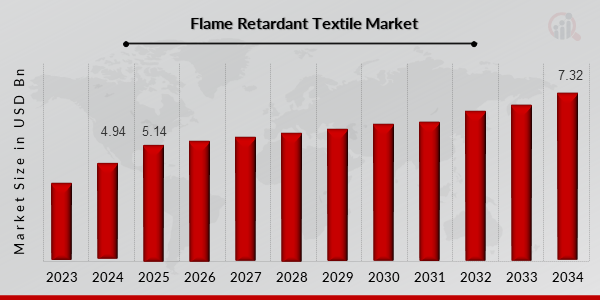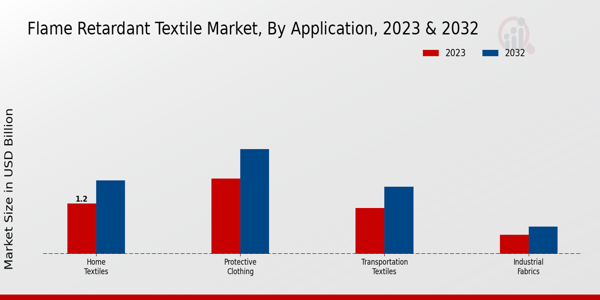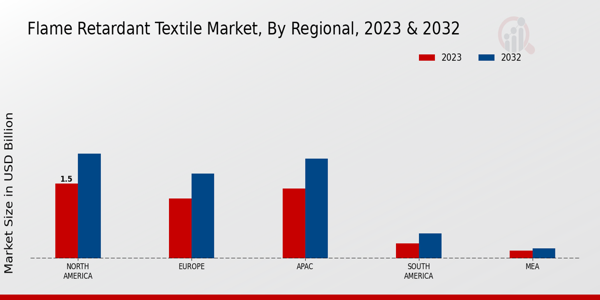Global Flame Retardant Textile Market Overview
The Flame Retardant Textile Market Size was estimated at 4.94 (USD Billion) in 2024. The Flame Retardant Textile Industry is expected to grow from 5.14 (USD Billion) in 2025 to 7.32 (USD Billion) by 2034. The Flame Retardant Textile Market CAGR (growth rate) is expected to be around 4.0% during the forecast period (2025 - 2034).
Key Flame Retardant Textile Market Trends Highlighted
The Flame Retardant Textile Market is influenced by several factors driving its growth, such as increasing safety regulations and rising demand for protective clothing across various sectors. Industries like construction, automotive, and aerospace require materials that comply with fire safety standards, creating a consistent need for flame retardant textiles. The growing awareness of fire hazards and the importance of safety measures among consumers further support market expansion. Additionally, advancements in technology contribute to the development of new flame retardant materials that not only enhance safety but also offer improved comfort and performance.On the market, it is worth noticing the possibility of fostering new ideas based on the research and development activities currently underway. Since industries are preparing for enhanced fire regulations, manufacturers can now turn their efforts towards creating eco-friendly flame retardant chemicals that will address these regulations. Another opportunity that is emerging as a result of the growing demand for sustainability is the use of bio-based or recycled materials to produce flame retardant textiles. Such innovations will address the growing concern among businesses and consumers on how they can incorporate eco-friendly practices into their operations and conduct. The recent past has experienced a change in consumer habits where they seek more stylish and practical flame retardant textiles.This trend has led manufacturers to explore designs that are not only safe but also visually appealing, increasing their application in everyday clothing and home furnishings. Furthermore, the integration of smart technologies, such as moisture-wicking and temperature-regulating features, into flame retardant textiles has become more prevalent. This enhances user comfort while maintaining the necessary safety standards, driving innovation in the market and responding to consumer needs effectively. As these developments unfold, the Flame Retardant Textile Market continues to evolve, showcasing a blend of safety, functionality, and design.

Source: Primary Research, Secondary Research, MRFR Database and Analyst Review
Flame Retardant Textile Market Drivers
Rising Safety Regulations and Standards
The Flame Retardant Textile Market Industry is significantly driven by the increasing enforcement of safety regulations and standards across various sectors such as automotive, construction, and manufacturing. Governments and industry bodies are establishing stringent guidelines to enhance fire safety measures. This regulatory environment is compelling manufacturers to develop and adopt flame retardant textiles that comply with these standards.The importance of fire safety in both public and private sectors has led to a heightened focus on materials that can mitigate fire hazards. Consequently, manufacturers are prioritizing innovation in developing advanced flame retardant textiles to meet these regulatory requirements and ensure public safety. Compliance not only enhances product credibility but also opens new market opportunities as consumers increasingly seek safety-tested materials.With the market stakeholders emphasizing adherence to these safety standards, the demand for flame retardant textiles is expected to rise, further driving the growth of the Flame Retardant Textile Market Industry. Moreover, as industries evolve and new applications for flame retardant textiles arise, the regulatory framework is expected to adapt, further underlining the importance of compliance and safety in textile production.
Growing Demand in Emerging Economies
The Flame Retardant Textile Market Industry is experiencing significant growth due to rising demand in emerging economies. As countries develop and urbanize, there is a notable increase in construction and manufacturing activities, leading to a heightened requirement for flame retardant materials. The growing middle class in these regions is becoming more aware of safety standards, driving the demand for textiles that offer fire resistance.Additionally, investments in infrastructure and improvements in public safety measures are pushing industries to adopt flame retardant textiles, creating opportunities for market players to capitalize on this expanding demand.
Innovation in Flame Retardant Technologies
Technological advancements in flame retardant technologies are a key driver for the Flame Retardant Textile Market Industry. Manufacturers are investing in research and development to create innovative flame retardant solutions that are both effective and sustainable. This includes the development of novel chemical treatments, inherently flame-resistant fabrics, and eco-friendly alternatives. As consumers become more environmentally conscious, the demand for sustainable flame retardant textiles is increasing, prompting companies to integrate green practices into their production processes.The ongoing innovation in this field not only enhances product functionality but also broadens the application scope for flame retardant textiles across various industries.
Flame Retardant Textile Market Segment Insights
Flame Retardant Textile Market Application Insights
The Flame Retardant Textile Market revenue is significantly influenced by its Application segment, which includes diverse areas such as Home Textiles, Protective Clothing, Transportation Textiles, and Industrial Fabrics. In 2023, the overall market was valued at 4.56 USD Billion, with a noticeable distribution across these applications. Home Textiles held a notable valuation of 1.2 USD Billion, growing to 1.75 USD Billion by 2032, emphasized by an increased consumer focus on safety and fire-resistant materials in everyday fabrics. Protective Clothing dominated the market with a valuation of 1.8 USD Billion in 2023 and is projected to expand to 2.5 USD Billion by 2032; this segment is critical for safeguarding workers in various industries from fire hazards, emphasizing its significant role in maintaining occupational safety.Transportation Textiles, valued at 1.1 USD Billion in 2023, are another important area, projected to reach 1.6 USD Billion by 2032. The focus on fire safety in vehicles, aircraft, and marine sectors drives the growth of this application. Meanwhile, Industrial Fabrics, although comparatively smaller with a valuation of 0.46 USD Billion in 2023 and increasing to 0.65 USD Billion by 2032, play a crucial role in specialized applications, including firefighting equipment and protective barriers. The Flame Retardant Textile Market segmentation highlights how each application contributes to enhancing safety in various environments, with Protective Clothing holding a majority share, signifying its essential function in high-risk professions. The ongoing trends emphasize sustainability and the development of innovative flame retardant technologies, which present both challenges and opportunities for all segments involved. Understanding the Flame Retardant Textile Market data allows stakeholders to navigate this evolving landscape effectively, ensuring that safety, compliance, and performance are prioritized across these key applications.

Source: Primary Research, Secondary Research, MRFR Database and Analyst Review
Flame Retardant Textile Market Fiber Type Insights
In 2023, the Flame Retardant Textile Market is valued at 4.56 billion USD, driven by an increasing demand for safety in various applications. The market segmentation around Fiber Type includes Natural Fibers, Synthetic Fibers, and Blended Fibers, each playing a pivotal role in the market. Synthetic Fibers dominate due to their superior flame-retardant properties and widespread use across industries such as automotive and protective clothing, providing enhanced safety and durability. Natural Fibers, while considered sustainable and environmentally friendly, face challenges in achieving the same level of flame resistance as synthetic alternatives, yet they hold a significant position due to growing consumer preference for sustainable materials.Blended Fibers, combining the benefits of both Natural and Synthetic Fibers, are increasingly important, offering a balanced approach to performance and environmental concerns. The Flame Retardant Textile Market data reveals a steady growth trend influenced by stringent safety regulations and advancements in fiber technology, emphasizing both challenges and opportunities in balancing safety, environmental impact, and quality across these fiber types. As the industry evolves, these segments highlight the critical aspects of flame retardancy in textiles, reflecting broader market growth initiatives.
Flame Retardant Textile Market End Use Insights
The Flame Retardant Textile Market is poised to cater to diverse end-use sectors with a cumulative market value projected at 4.56 billion USD in 2023, reflecting its broad utilization across various industries. Each sector, including Aerospace, Automotive, Construction, and Healthcare, utilizes flame retardant textiles due to their critical role in enhancing safety and compliance with regulations. The aerospace industry relies heavily on these textiles for insulation and safety applications, while the automotive sector increasingly adopts flame retardant fabrics to meet stringent safety standards and enhance passenger safety.In construction, flame retardant textiles are pivotal in improving fire safety regulations within buildings, significantly contributing to reducing risk. The healthcare sector sees substantial usage as well, where flame retardancy is crucial in textiles used for patient bedding and medical gear, ensuring a safer environment for patients and staff. This segmentation underlines the importance of flame retardant textiles, facilitating growth opportunities across these industries as they seek to enhance safety features and performance standards. The Flame Retardant Textile Market data reflects a trend towards greater adoption of these materials, driven by rising safety concerns and regulatory pressures across all end-use segments.
Flame Retardant Textile Market Flame Retardant Type Insights
The Flame Retardant Textile Market, projected to be valued at 4.56 billion USD in 2023, showcases a diversity of flame retardant types that cater to various industrial needs. Among these, the Additive type has garnered considerable attention due to its ability to be blended with existing materials without altering their inherent properties. This flexibility makes it a key player in the market. Similarly, the Reactive type, often chemically bonded to the textile fibers, ensures enhanced durability and long-lasting protection, fulfilling stringent safety standards in sectors such as construction and automotive.Coating types offer another layer of protection, adding value by providing superior barrier properties against flames and heat, thus addressing rising safety concerns across multiple applications. The growth of the Flame Retardant Textile Market is supported by stringent safety regulations and increasing demand for fire-resistant textiles. However, challenges such as environmental regulations surrounding certain chemicals in these flame retardants continue to influence market dynamics. Overall, the Flame Retardant Textile Market data reveals a promising trajectory facilitated by innovations and heightened safety awareness among manufacturers and consumers alike.
Flame Retardant Textile Market Regional Insights
The Regional segment of the Flame Retardant Textile Market shows distinct variations in market valuation and growth prospects across different regions. In 2023, North America holds a dominant position with a valuation of 1.5 USD Billion, which is expected to grow significantly to 2.1 USD Billion by 2032. Europe follows with a market valuation of 1.2 USD Billion in 2023, projected to reach 1.7 USD Billion, highlighting its importance due to stringent safety regulations in the textile industry. The Asia-Pacific (APAC) region, valued at 1.4 USD Billion in 2023 and anticipated to grow to 2.0 USD Billion, indicates a robust demand driven by increasing manufacturing activities and textile exports.South America is relatively smaller in comparison, with a valuation of 0.3 USD Billion in 2023, expected to reach 0.5 USD Billion, reflecting growing market interest but ongoing economic challenges. Lastly, the Middle East and Africa (MEA) region, valued at 0.16 USD Billion and growing to 0.2 USD Billion, is on the rise due to the increasing awareness of fire safety standards. Each region contributes uniquely to the overall Flame Retardant Textile Market revenue, showcasing varied growth rates and market dynamics influenced by local regulations, manufacturing capabilities, and safety concerns.

Source: Primary Research, Secondary Research, MRFR Database and Analyst Review
Flame Retardant Textile Market Key Players and Competitive Insights
The Flame Retardant Textile Market is characterized by a dynamic competitive landscape driven by various regional and international players who are continually innovating to meet growing demand across numerous sectors, including construction, automotive, and apparel. The increasing awareness regarding fire safety and stringent regulatory frameworks ly are propelling manufacturers to develop advanced flame retardant textiles. Companies are focusing on enhancing the performance characteristics of their products while increasing their presence in emerging markets. Effective competition is observed through strategic partnerships, mergers, acquisitions, and the launch of new products tailored to meet specific industry requirements, aiming to gain market share and enhance their offerings in terms of safety and compliance.Kraton has established a strong footing in the Flame Retardant Textile Market through its innovative product lines and a strong focus on research and development. The company is recognized for its ability to produce high-quality flame retardant additives that are integrated into various textile applications, providing enhanced fire resistance without compromising the fabric's feel or flexibility. With a commitment to sustainability and compliance with environmental regulations, Kraton has developed advanced flame retardant solutions that not only meet the necessary industry standards but also cater to evolving consumer preferences for safer and more environmentally friendly products. This strategic approach, coupled with its robust distribution channels, allows Kraton to maintain a competitive edge in the market landscape.Nexeo Solutions plays a significant role in the Flame Retardant Textile Market by providing a comprehensive portfolio of flame retardant materials tailored for diverse industries. The company leverages its technical expertise to develop customized solutions that meet specific flame retardant requirements while ensuring high performance and durability. Nexeo Solutions emphasizes strong customer relationships, delivering tailored support that aids clients in optimizing their product offerings and enhancing safety measures. Additionally, Nexeo Solutions focuses on facilitating innovation by collaborating with key stakeholders and staying ahead of industry trends, further solidifying its position in the competitive arena of flame retardant textiles. The ability to adapt to market needs while maintaining stringent quality standards positions Nexeo Solutions as a key player in the flame retardant textile sector.
Key Companies in the Flame Retardant Textile Market Include
Flame Retardant Textile Market Industry Developments
The Flame Retardant Textile Market has been witnessing several remarkable developments recently. Companies such as Kraton, Solvay, and Huntsman have focused on enhancing their product portfolios, especially in environmentally friendly flame retardant solutions, responding to the increasing regulatory pressures and consumer demand for safer and sustainable textiles. Mergers and acquisitions remain a strategic trend, with firms seeking to leverage synergies to drive innovation; for instance, recent consolidations involving Koppers and Albemarle highlight industry consolidation aimed at improving supply chain efficiencies and market reach. Notably, BASF has expanded its operations in Asia to tap into emerging markets, indicating a robust growth trajectory in regions that require advanced flame retardant solutions. Additionally, companies like Clariant and DuPont are aligning their research efforts toward innovative applications that cater to diverse sectors such as automotive, construction, and industrial textiles, thereby promising enhanced growth in market valuation. This competitive landscape is shaping the future of flame retardant textiles, driven by technological advancements and strategic collaborations among key players like Nexeo Solutions, Sherwin-Williams, and Lanxess.
Flame Retardant Textile Market Segmentation Insights
Flame Retardant Textile Market Application Outlook
Flame Retardant Textile Market Fiber Type Outlook
Flame Retardant Textile Market End Use Outlook
Flame Retardant Textile Market Flame Retardant Type Outlook
Flame Retardant Textile Market Regional Outlook
| Report Attribute/Metric |
Details |
| Market Size 2024 |
4.94 (USD Billion) |
| Market Size 2025 |
5.14 (USD Billion) |
| Market Size 2034 |
7.32 (USD Billion) |
| Compound Annual Growth Rate (CAGR) |
4.0% (2025 - 2034) |
| Report Coverage |
Revenue Forecast, Competitive Landscape, Growth Factors, and Trends |
| Base Year |
2024 |
| Market Forecast Period |
2025 - 2034 |
| Historical Data |
2020 - 2024 |
| Market Forecast Units |
USD Billion |
| Key Companies Profiled |
Kraton, Nexeo Solutions, Koppers, Solvay, Huntsman, SherwinWilliams, Clariant, Tencate, Albemarle, BASF, Innospec, DuPont, Agrochem, Lanxess, Eastman Chemical |
| Segments Covered |
Application, Fiber Type, End Use, Flame Retardant Type, Regional |
| Key Market Opportunities |
Sustainable material innovations, Rising industrial safety regulations, Growing demand in the construction sector, Expansion in protective clothing market, Increasing consumer awareness on safety |
| Key Market Dynamics |
Increasing safety regulations, Rising demand in industrial applications, Technological advancements in materials, Growing awareness of fire hazards, Expanding applications in the automotive industry |
| Countries Covered |
North America, Europe, APAC, South America, MEA |
Frequently Asked Questions (FAQ) :
The Flame Retardant Textile Market is expected to be valued at 7.32 billion USD in 2034.
The expected CAGR for the Flame Retardant Textile Market is 4.0% from 2025 to 2034.
North America is projected to have the highest market value at 2.1 billion USD in 2034.
The Home Textiles segment is expected to grow from 1.2 billion USD in 2025 to 1.75 billion USD in 2034.
Kraton is one of the major players significantly impacting the Flame Retardant Textile Market.
The Protective Clothing segment is projected to reach 2.5 billion USD in 2034.
Industrial Fabrics are expected to reach a market size of 0.65 billion USD by 2034.
The Transportation Textiles segment is expected to grow from 1.1 billion USD in 2025 to 1.6 billion USD in 2034.
The market for Flame Retardant Textiles in South America is expected to reach 0.5 billion USD by 2034.
The APAC region's market is expected to grow to 2.0 billion USD by 2034 from 1.4 billion USD in 2024.
















